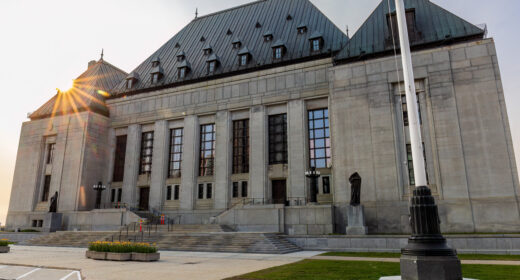Patent
There are a couple of important practice changes (stems from amendments to the Canadian Patent Rules), which came into force on June 2, 2007.
I. Declaration at the time of filing
Background:
In order for the Canadian Intellectual Property Office ("CIPO") to keep its records up to date with respect to the chain of title for applications/patents, the Patent Rules require an applicant who is not the inventor to file evidence that the applicant is entitled to apply for and be granted a patent. Currently, the applicant must provide evidence such as assignments, affidavits or statutory declarations and pay the associated fee to register these legal documents with the CIPO.
Amendment:
In keeping with the Canadian government's initiative to reduce the administrative burden on businesses, the amendment to the Patent Rules is made to provide such evidence be replaced with a requirement to provide the information by way of a simple declaration either in the petition or on a separate form.
The amendment is consistent with the requirements under the PCT and also reflects the international trend in Patent Offices to move towards a simpler way of providing this type of information. Please note that such declaration is applicable only to those events (such as signing of an assignment from the inventors to the applicant) that had occurred before the filing date; however, if the transfer of entitlement occurred after the filing date, pursuant to Section 38 of Canadian Patent Rules, a copy of the document effecting such transfer (i.e. assignment), instead of declaration, must be filed accordingly to the Canadian Patent Office and pay the government fee of CDN$100.
How does this change affect your client:
In order to take advantage of this change and save your client having to pay the CDN$100 government assignment recordal fee, when sending your Order Letter, you should advise us whether an assignment has been executed prior to the Canadian application filing date. If yes, we can include the assignment declaration in the petition.
II. Small Entity
Background:
The Patent Act and Patent Rules require patent applicants/ holders to pay certain government fees. Prior to 1985, there was no distinction of fees based upon entity size. In 1985, the Canadian government introduced "small entity" provisions to encourage universities and small businesses to use the patent system by reducing certain fees by 50%. This discount amounts to savings for the patent applicant/holder of up to $3,000 over the life of a patent.
Prior to 2003, it was the practice of the CIPO to accept "top-up" payments if entities mistakenly paid small entity fees but later realized that they should have paid the regular fees. In 2003, however, the Federal Court of Appeal's decision in Dutch Industries Ltd. v. The Commissioner of Patents, Barton No-Till Disk Inc. and Flexi-Coil Ltd.("Dutch Industries") held that the Commissioner of Patents lacked the authority to accept these "top-up" payments. The Court also ruled that a patent applicant/holder's entity status-small or large-is determined when the patent regime is first engaged (generally when a patent application is submitted) and that this status is maintained throughout the life of the patent. The Court's decision put thousands of patents at risk, as they could be invalidated if challenged. Section 2 of An Act to amend the Patent Act was therefore enacted to provide retroactive relief to patent holders and applicants affected by the Dutch Industries decision. It provides a one-year time limit to correct past fees that were incorrectly paid at the small entity level. This section came into force on February 1, 2006. However, there are very limited provisions to provide relief in instances where small entity fees are mistakenly paid after February 1, 2006. As a result, entities whose status is ambiguous under the Patent Rules have been reluctant to take the risk of taking advantage of the 50% reduction in certain fees, fearing that the patent could be invalidated. This is evidenced by CIPO's data, which indicates that small entities currently amount to only 11% of patent applications received (as opposed to 22% in 2000).
Amendments:
The intent of the amendments to the Patent Rules is to encourage the use of small entity provisions by removing the uncertainty surrounding the small entity regime. The amendments clarify the definition of small entity, the relevant date on which small entity status is to be assessed, the nature of the declaration by patent applicants and holders that they are entitled to pay at the small entity level, and the time within which the declaration must be made. The proposed amendments also put in place a corrective mechanism that enables patent holders and applicants to obtain an extension of time to fix up payments that have been made incorrectly at the small entity level.
More specifically, it has been amended that:
- the definition of "small entity" be refined to mean an entity that employs 50 or fewer employees or that is a university, and that is not controlled by nor has transferred or licensed its obligation to an entity that employs more than 50 people;
- the small entity status for a regularly filed application is to be determined on the filing of the application for non-PCT national phase applications, and at national entry for PCT national phase applications;
- patent applicants/holders must submit a small entity declaration, in the petition or in a separate document, stating that they believe that they are entitled to pay fees at the small entity level;
- if patent applicants/holders wish to pay as a small entity, they must submit the small entity declaration at the time of payment or, if they pay their fees before the prescribed due date, they should submit the declaration before that deadline;
- the Commissioner of Patents be authorized to grant patent applicants/holders an extension of time that will permit the correction of fees mistakenly paid at the small entity level;
- fee corrections made pursuant to the relief mechanism would only be permitted if the patent applicant/holder makes a statement that the small entity fee was paid in good faith and the application for an extension is filed without undue delay; and
- patent applicants/holders would be required to pay the difference in fees and the prescribed fee for requesting an extension of time.
How does this change affect your client:
In order to take advantage of the Small Entity status savings, when sending your Order Letter, you should advise us whether the applicant meets the Canadian small entity definition. If yes, we can include the Small Entity declaration in the petition.
Trademark
I. Changes to Extension of Time Limits related to Opposition Proceedings
Background:
Generally, after examination of a trademark application, the Canadian Registrar of Trade-marks publishes the application in the Trade-marks Journal to serve notice to the public that the application has been considered and, barring successful opposition, will be allowed. If individuals or companies believe that the advertised trademark is in conflict with their interests, they may file a Statement of Opposition with the Trade-marks Opposition Board (TMOB). The other party will be informed and will be allowed to respond with a counter-statement. After evidence has been exchanged, the parties may request that an oral hearing be held before the TMOB issues a final decision in the case.
Under the current Trade-marks Regulations, parties are subject to various time limits for providing their documents in an opposition proceeding. As these time limits are fairly short, parties (applicants as well as opponents) often request a time extension with the payment of a fee. In general, the Registrar of Trade-marks has been using the Registrar's discretion to grant a time extension.
Given that most parties tend to request and be granted a time extension, it is proposed that some of the time limits in the current Trade-marks Regulations be extended, thereby avoiding the associated administrative burden and costs for the parties to seek extensions and for the Registrar of Trade-marks to consider these requests.
Amendment:
The amendment to the Trade-marks Regulations will increase the time limit for filing a counter-statement from one month to two months, and from one month to four months for filing opponent's evidence under Rule 41 and applicant's evidence under Rule 42.
This would ensure an efficient procedure where parties would have sufficient time set out in the Regulations to prepare their documents without the administrative burden and cost for requesting additional time extensions. CIPO would subsequently amend its current practice and reduce the amount of time extensions it normally grants for parties to meet their obligations to submit documents.
The amendment does not affect the right of the parties to continue to request for additional time extensions beyond the newly amended timeframe, provided the circumstances justify such a request.
How does this change affect your client:
The extended time limits will afford your client more time to decide on filing a counter-statement (if an applicant) as well as more time to prepare and submit evidences, thereby saving the costs and professional fees on submitting time extension requests.
Coming into force:
This amendment came into force on October 1, 2007.
II. Eliminating Government Fees for Recording Name and/or Address Changes for Trademark Registrations
Background:
Under the current Trade-marks Regulations and Tariffs, trademark registrants are required to pay CDN$50 to record a name and/or address change(s).
Amendment:
The amendment to the Trade-marks Regulations and Tariffs will eliminate such fees.
Your client is no longer required to pay the prescribed government fees for recording a name and/or address change(s).
Coming into force:
This amendment came into force on June 2, 2007.


